HM-Analyzer-I (for NexGen I2M)
Our HM-Analyzer maps from one to 15 inertial sensors to various segments of the body (such as trunk, pelvis, arms, etc.) in order to obtain joint angles according to ISB - International Society of Biomechanics (ISB angles are also anatomical angles) or according to AAOS. The software and system are totally scalable allowing you to use any number of sensors as required. The skeleton which is used for visualization can be adjusted according to the subject's anthropometry.
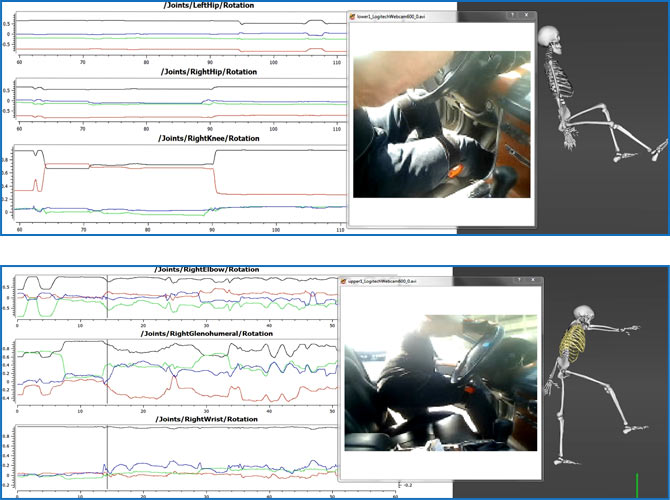
The software takes care of joint definitions and conversions. The user simply needs to identify the segment that is mapped to the specified sensor.
The application synchronizes the data automatically. The user can then perform various analyses within HM-Analyzer or export data. Processing and analysis of off-line or data stored on the built-in inertial sensor memory is also handled by HM-Analyzer.
The calibration procedure consists of the user selecting either the T-pose or I-pose (posture) and clicking "Calibrate" or using the auto-calibration option.
Animation allows you to replay a recording. You can zoom in and out on the graphs using the mouse wheel.
Recording duration time can be set manually or automatically by specifying the start and end recording time.
HM-Analyzer includes synchronization capability (requires optional hardware Synch kit) with the Biometrics DataLOG (as slave or master) with EMG, force plates as well as other sensors and accessories. As well, there is an option to synch with a webcam.
DATS (Data Analysis Tool Set) Module
The DATS (Data Analysis Tool Set) module is included and performs a variety of joint angle analysis, filtering and data export. The DATS module provides a graphical user interface (GUI) to perform data analysis. The analysis can be done with streaming (real-time) data or with data that was previously recorded.
The interface uses a graph layout to create various analyses. Tools are available to easily connect the graphical blocks. Data processing block layouts can be saved for reuse.
The DATS module includes various filtering options, biomechanical tools to calculate joint angles (according to the ISB or AAOS) as well as various signal processing tools.
DATS also includes a variety of data filtering options that can be applied which include Butterworth, Chebyshev (1 & 2) and Bessel.
Saved analysis can be saved for reuse or future modifications.
Ergo-Analyzer Module
Ergo-Analyzer is an optional HM-Analyzer module that includes the RULA (Rapid Upper Limb Assessment) and OWAS (Ovako Working Posture Analysis System) ergonomic methods.
RULA Analysis
RULA (rapid upper limb assessment) is a survey method developed for use in ergonomics investigations of workplaces where work-related upper limb disorders are reported. The RULA method can be used to analyze right and/or left upper limbs, neck, trunk and legs postures at selected instants or continuously at a predefined frequency by the users.
The results of the RULA analysis can be saved as .odt or .html files.

RULA Screen Examples
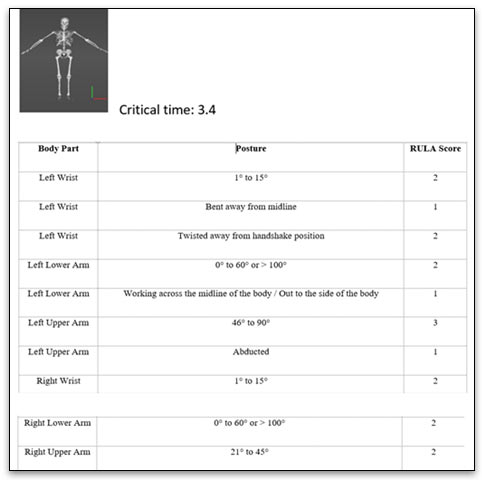
RULA Report Excerpt
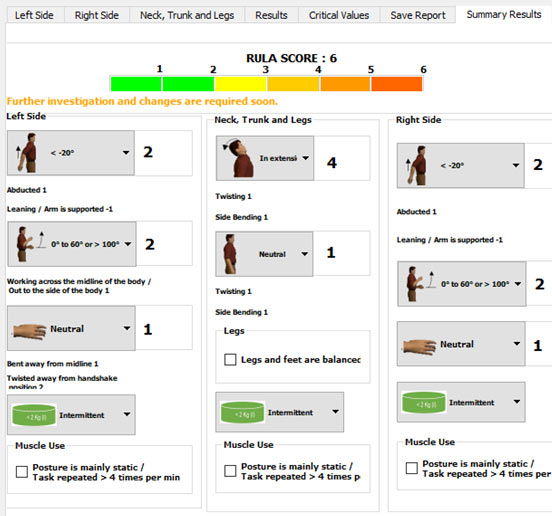
RULA Summary Results Screen
The Summary Results screen displays the Left and Right sides results as well as those for the Neck, Trunk and Legs as well as their RULA scores. The forces and weights applied on each chain (right side, left side and Neck-Trunk chain) are also displayed in combo boxes. The RULA grand scores are displayed as colored bars with values.
OWAS Analysis
OWAS (Ovaka Working Posture Assessment System) was developed in Finland in a steel industry company, Ovako Oy, in 1973 to describe the workload in the overhauling of iron smelting ovens (Karhu 1977). It identifies the most common work postures for the back (4 postures), arms (3 postures) and legs (7 postures), and weight of the load handled (3 categories). Whole body posture is described by these body parts with a four digit-code. These 252 postures have been classified to four action categories indicating needs for ergonomic changes. The observations are made as "snapshots" and sampling has usually been with constant time intervals.
The OWAS method can also be used to analyze a global task through its duration by setting the percentages of the postures held by the subject over the task duration and for every body part.
The results of the OWAS analysis can be saved as .odt or .html files.
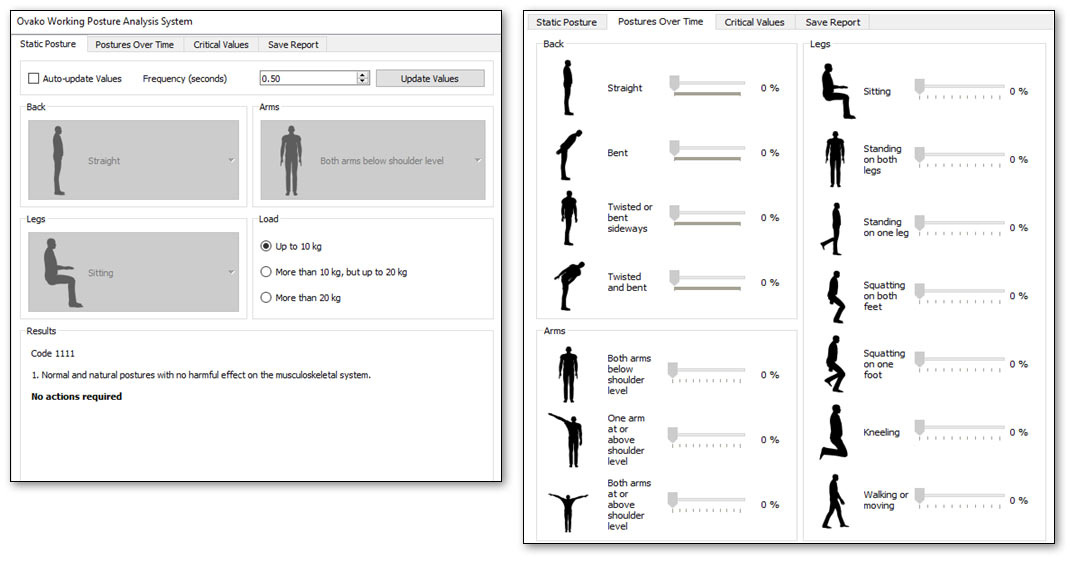
OWAS Screen Examples
The obtained results are categorized according to their severity (moderate, severe and extreme). The users can include all results and/or each category of results. Based on the number of critical events contained in the analysis, a number of reports will be generated.
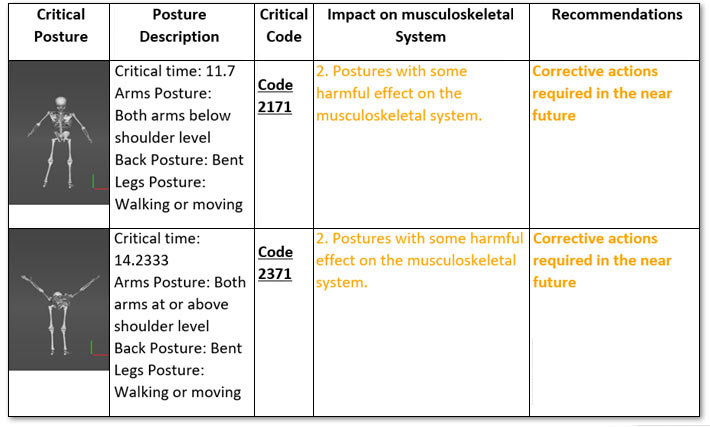
OWAS Report Excerpt
Main Features
- Capture motion orientation information from inertial sensors.
- Easily map segments of a 3D model skeleton to inertial sensors and mappings can be saved to be reused in subsequent data acquisition to save time.
- Dynamically display Euler or Quaternion orientation data as a scrolling, 2D graph.
- Record multiple recordings each can be subsequently analyzed further and animated.
- Display recorded data as a static, 2D graph.
- The center of mass and center of gravity is displayed on the 3D skeleton.
- Ability to customize 3D skeleton anthropometry
- Apply filters (APDF, Bessel, Butterworth, Chebyshev I, Chebyshev II, Differentiation, Rectification, Acceleration and Velocity) to streaming (real time) data or recorded data.
- DATS calculates anatomical angles of a selected limb and displays the data in real-time. ISB (International Society of Biomechanics) and AAOS conventions are supported.
- Data can be synched with webcam.
- When using DATS, data can be exported to HDF5 format, CSV & C3D.
- A variety of calibration options (mag, gyro, T/I pose)
- Several filtering options available which include Butterworth, Chebyshev and, rectification filters
- Various data options such as Quaternion Splitter, Vector 4D Splitter, Quaternion Multiplexer, Euler to Quaternion Converter
- Threshold alarm: Values outside the threshold are displayed in red in the real-time graphs.
- Repetitions: The software will provide a total of repetitions defined by an algorithm. As well, each repetition can be visually identified on the graph.
- New position calibration options including horizontal for analyzing postures when the subject is in a horizontal position.
- Export graphs as images.
- Range of Motion scoring: The user can assign their own ranges of motion to score the movement against. This scoring is by segment and the user can assign the joint angle ranges with a corresponding color code assigned by the analyst.
Current release version: V5.0
Minimum System Requirements
- Microsoft Windows 7, 8 & 10
- Intel/AMD CPU, dual-core 2.0 GHz or more (i5 or equivalent recommended) for 6 IMUs or less. For 10+ IMUs running 64 or 128Hz, i5+ with 2.8 GHz quad core is the suggested minimum (or similar to i5-650 dual core hyperthreaded @ 3.2 GHz).
- 6GB of RAM (8GB recommended)
- 1GB of hard disk space
- USB 2.0 ports (minimum 2, more depending on docking stations, IMUs)
- 3D Hardware accelerated graphics card (AMD or nVidia recommended)


